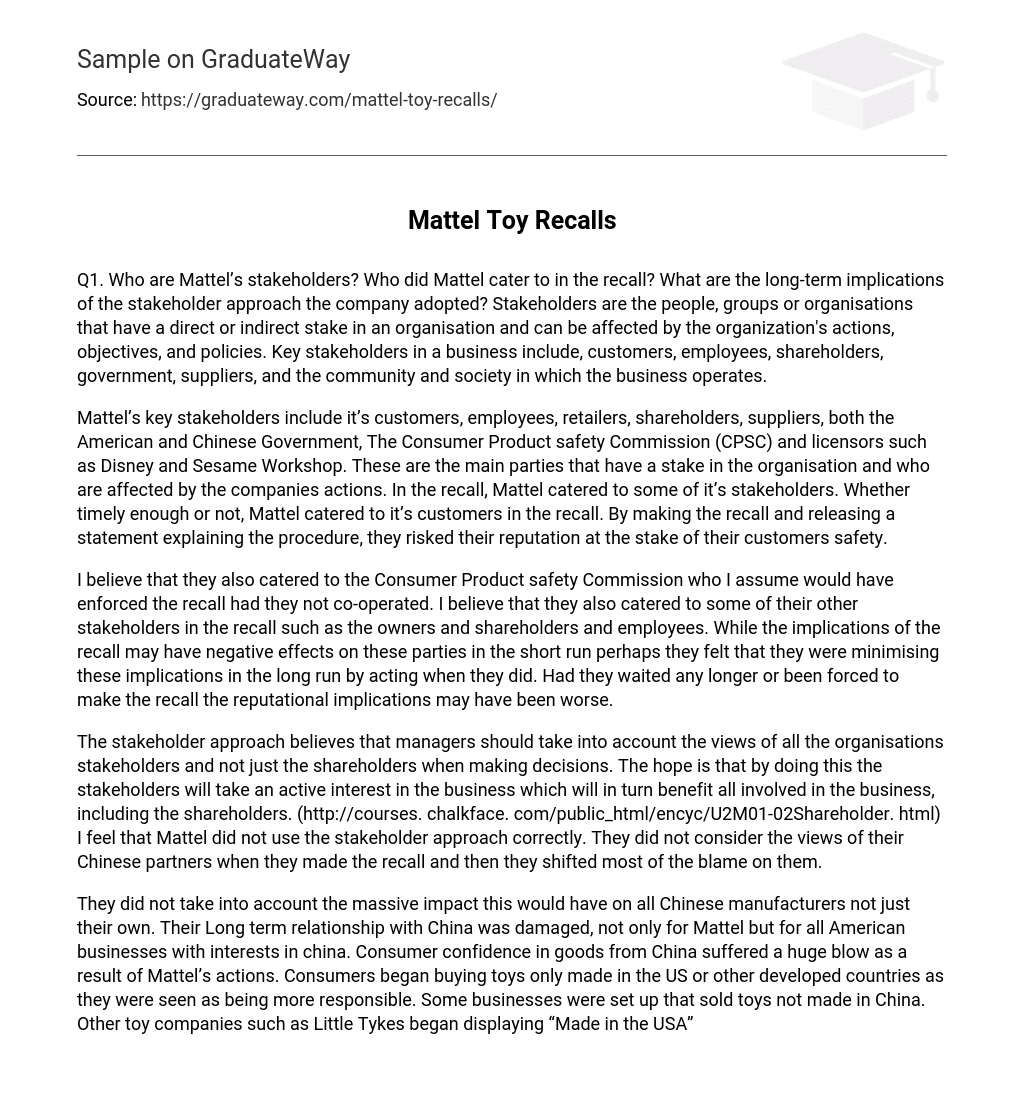Q1. Who are Mattel’s stakeholders? Who did Mattel cater to in the recall? What are the long-term implications of the stakeholder approach the company adopted? Stakeholders are the people, groups or organisations that have a direct or indirect stake in an organisation and can be affected by the organization’s actions, objectives, and policies. Key stakeholders in a business include, customers, employees, shareholders, government, suppliers, and the community and society in which the business operates.
Mattel’s key stakeholders include it’s customers, employees, retailers, shareholders, suppliers, both the American and Chinese Government, The Consumer Product safety Commission (CPSC) and licensors such as Disney and Sesame Workshop. These are the main parties that have a stake in the organisation and who are affected by the companies actions. In the recall, Mattel catered to some of it’s stakeholders. Whether timely enough or not, Mattel catered to it’s customers in the recall. By making the recall and releasing a statement explaining the procedure, they risked their reputation at the stake of their customers safety.
I believe that they also catered to the Consumer Product safety Commission who I assume would have enforced the recall had they not co-operated. I believe that they also catered to some of their other stakeholders in the recall such as the owners and shareholders and employees. While the implications of the recall may have negative effects on these parties in the short run perhaps they felt that they were minimising these implications in the long run by acting when they did. Had they waited any longer or been forced to make the recall the reputational implications may have been worse.
The stakeholder approach believes that managers should take into account the views of all the organisations stakeholders and not just the shareholders when making decisions. The hope is that by doing this the stakeholders will take an active interest in the business which will in turn benefit all involved in the business, including the shareholders. (http://courses. chalkface. com/public_html/encyc/U2M01-02Shareholder. html) I feel that Mattel did not use the stakeholder approach correctly. They did not consider the views of their Chinese partners when they made the recall and then they shifted most of the blame on them.
They did not take into account the massive impact this would have on all Chinese manufacturers not just their own. Their Long term relationship with China was damaged, not only for Mattel but for all American businesses with interests in china. Consumer confidence in goods from China suffered a huge blow as a result of Mattel’s actions. Consumers began buying toys only made in the US or other developed countries as they were seen as being more responsible. Some businesses were set up that sold toys not made in China. Other toy companies such as Little Tykes began displaying “Made in the USA” labels on their toys.
In retaliation, China rejected certain goods from the US and Canada and relations between the two countries were severely damaged. In the short run, Mattel’s share price and reputation suffered but in the long term they may be seen as having acted responsibly and having put childrens safety first. If they prove to consumers that they have learnt from mistakes they may be able regain trust. In the long run, Mattel should have more faith in the stakeholder approach. They need to study the area again and update their policy.
They seem to have missed out on the key points. The company should be more forward thinking. They should develop better relationships with their partners that are more cooperative and accountable and which benefit all parties involved. They should also provide their manufacturers with education and training and enforce random auditing systems. According to Pirson And Malhotra (2008) It is not enough to be honest with stakeholders. High intensity stakeholders such as consumers need to perceive that the organisation also cares about the individuals well being.
One feature that distinguishes high integrity firms that destroy trust from high integrity firms that salvage or build trust is the degree to which the firms signal and communicate a concern for the well-being of individual consumers. Mattel should take this view into account for the future. Mattel’s licensors such as Disney and Sesame Workshop may feel very dissatisfied and question whether they should continue to license their brand to Mattel in the future unless they show dedication to all stakeholders. In the long run, Mattel should follow Shultz (2007) in his thinking on constructive engagement.
All stakeholders must have a greater appreciation for the amalgamation of consumer interests, government interests, corporate profit motives, and global concerns about sustainability. Conflicting stakeholder interests should be factored into negotiated agreements; otherwise, more powerful stakeholders will have little incentive to engage constructively, reducing the probability for win–win outcomes for the largest number of stakeholders engaged, Firms who adopt this are more likely to have sustainable commercial success.





